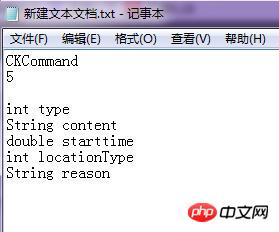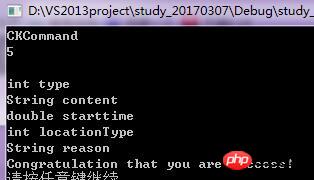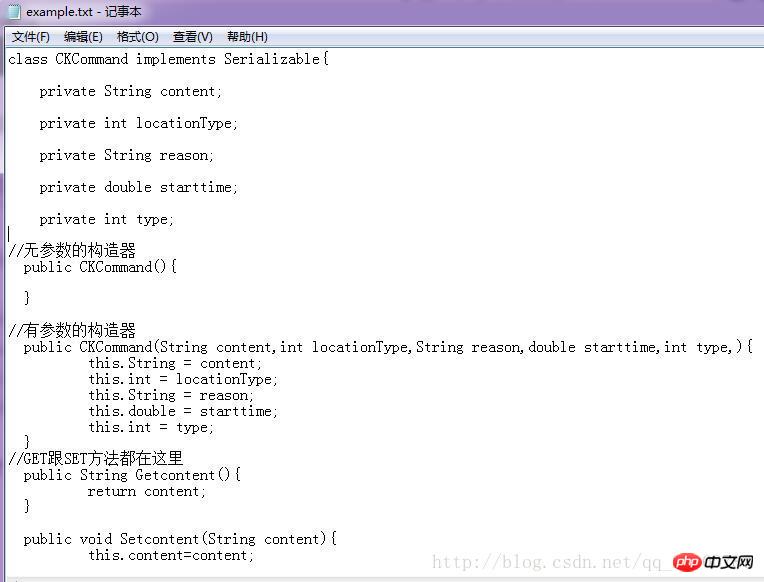Use entity class tools to generate Java implementation from C++
前言
原因是这样的,eclipse有那种生成实体类的插件,可是我感觉装来装去很麻烦,于是我想,干脆自己做一个生成实体类的工具吧,说做就做,然后就自己花了两个小时左右做出来了一个,以后应该能大大提高工作效率吧。
实现方法
输入:属性个数
输入:type virableName
输出:d盘下面的example文件,该文件里面生成了实体类的代码
原理就是填充数据而已。。。根本没有难度
然后用了map模板把数据存起来了
使用截图

**这个是数据截图,CKCommand表示类,5表示有几个属性,剩下的都是数据属性
然后把这个数据复制进控制台运行就可以了**

运行截图
最后的实体类截图 
注意去D盘下面找
代码
#include <iostream>
#include <string>
#include <map>
#include <fstream>
using namespace std;
int main()
{
int num; //总体的成员个数
string which1, Vname,classname;
map<string, string > mapStudent; //这个我服了
map <string, string >::iterator m1_Iter;
cin >> classname;
cin >> num;
for (int i = 0; i<num; i++){
cin >> which1 >> Vname;
mapStudent[Vname] = which1;
}
cout << "Congratulation that you are success!"<<endl;
ofstream examplefile("d:\\example.txt");
if (examplefile.is_open())
{
examplefile << "class "<<classname<<" implements Serializable{\n\n";
for (m1_Iter = mapStudent.begin(); m1_Iter != mapStudent.end(); m1_Iter++){
//cout << "diyige " << m1_Iter->first << " " << m1_Iter->second.first << " " << m1_Iter->second.second << endl;
examplefile <<" private "<< m1_Iter->second << " " << m1_Iter->first <<";\n";
}
//first constructor
examplefile << "\n//无参数的构造器\n";
examplefile << " public " << classname << "(){\n";
examplefile << "\n";
examplefile << " }\n\n"; //第二个构造器
examplefile << "//有参数的构造器\n";
examplefile << " public " << classname << "("; //打印到括号地方了
for (m1_Iter = mapStudent.begin(); m1_Iter != mapStudent.end(); m1_Iter++){
if (m1_Iter != mapStudent.end()){
examplefile << m1_Iter->second << " " << m1_Iter->first << ",";
} else{
examplefile << m1_Iter->second << " " << m1_Iter->first;
}
}
examplefile << "){\n"; //构造函数里面的内容
for (m1_Iter = mapStudent.begin(); m1_Iter != mapStudent.end(); m1_Iter++){ //examplefile << m1_Iter->second.first << " " << m1_Iter->second.second << ",";
examplefile << " this." << m1_Iter->first << " = " << m1_Iter->first << ";\n";
}
examplefile << " }\n";
//----------------------------- 构造函数内容结束---------------------------------
//----------------------------- get方法开始--------------------------------------
examplefile << "\n//GET跟SET方法都在这里\n";
for (m1_Iter = mapStudent.begin(); m1_Iter != mapStudent.end(); m1_Iter++){ //examplefile << m1_Iter->second.first << " " << m1_Iter->second.second << ",";
//examplefile << "this." << m1_Iter->second.second << " = " << m1_Iter->second.second << "\n";
examplefile << " public " << m1_Iter->second << " Get" << m1_Iter->first << "(){\n";
examplefile << " return " << m1_Iter->first << ";\n";
examplefile << " }\n\n";
//--------------------------------set方法继续--------------------------------
examplefile << " public void Set" << m1_Iter->first << "(" << m1_Iter->second << " " << m1_Iter->first\
<< "){\n";
examplefile << " this." << m1_Iter->first << "=" << m1_Iter->first<< ";\n";
examplefile << " }\n\n";
}
//完结撒花
examplefile << "}\n";
examplefile.close();
}
system("pause"); return 0;
}The above is the detailed content of Use entity class tools to generate Java implementation from C++. For more information, please follow other related articles on the PHP Chinese website!

Hot AI Tools

Undresser.AI Undress
AI-powered app for creating realistic nude photos

AI Clothes Remover
Online AI tool for removing clothes from photos.

Undress AI Tool
Undress images for free

Clothoff.io
AI clothes remover

Video Face Swap
Swap faces in any video effortlessly with our completely free AI face swap tool!

Hot Article

Hot Tools

Notepad++7.3.1
Easy-to-use and free code editor

SublimeText3 Chinese version
Chinese version, very easy to use

Zend Studio 13.0.1
Powerful PHP integrated development environment

Dreamweaver CS6
Visual web development tools

SublimeText3 Mac version
God-level code editing software (SublimeText3)

Hot Topics
 1658
1658
 14
14
 1415
1415
 52
52
 1309
1309
 25
25
 1257
1257
 29
29
 1231
1231
 24
24
 Break or return from Java 8 stream forEach?
Feb 07, 2025 pm 12:09 PM
Break or return from Java 8 stream forEach?
Feb 07, 2025 pm 12:09 PM
Java 8 introduces the Stream API, providing a powerful and expressive way to process data collections. However, a common question when using Stream is: How to break or return from a forEach operation? Traditional loops allow for early interruption or return, but Stream's forEach method does not directly support this method. This article will explain the reasons and explore alternative methods for implementing premature termination in Stream processing systems. Further reading: Java Stream API improvements Understand Stream forEach The forEach method is a terminal operation that performs one operation on each element in the Stream. Its design intention is
 PHP: A Key Language for Web Development
Apr 13, 2025 am 12:08 AM
PHP: A Key Language for Web Development
Apr 13, 2025 am 12:08 AM
PHP is a scripting language widely used on the server side, especially suitable for web development. 1.PHP can embed HTML, process HTTP requests and responses, and supports a variety of databases. 2.PHP is used to generate dynamic web content, process form data, access databases, etc., with strong community support and open source resources. 3. PHP is an interpreted language, and the execution process includes lexical analysis, grammatical analysis, compilation and execution. 4.PHP can be combined with MySQL for advanced applications such as user registration systems. 5. When debugging PHP, you can use functions such as error_reporting() and var_dump(). 6. Optimize PHP code to use caching mechanisms, optimize database queries and use built-in functions. 7
 PHP vs. Python: Understanding the Differences
Apr 11, 2025 am 12:15 AM
PHP vs. Python: Understanding the Differences
Apr 11, 2025 am 12:15 AM
PHP and Python each have their own advantages, and the choice should be based on project requirements. 1.PHP is suitable for web development, with simple syntax and high execution efficiency. 2. Python is suitable for data science and machine learning, with concise syntax and rich libraries.
 PHP vs. Other Languages: A Comparison
Apr 13, 2025 am 12:19 AM
PHP vs. Other Languages: A Comparison
Apr 13, 2025 am 12:19 AM
PHP is suitable for web development, especially in rapid development and processing dynamic content, but is not good at data science and enterprise-level applications. Compared with Python, PHP has more advantages in web development, but is not as good as Python in the field of data science; compared with Java, PHP performs worse in enterprise-level applications, but is more flexible in web development; compared with JavaScript, PHP is more concise in back-end development, but is not as good as JavaScript in front-end development.
 PHP vs. Python: Core Features and Functionality
Apr 13, 2025 am 12:16 AM
PHP vs. Python: Core Features and Functionality
Apr 13, 2025 am 12:16 AM
PHP and Python each have their own advantages and are suitable for different scenarios. 1.PHP is suitable for web development and provides built-in web servers and rich function libraries. 2. Python is suitable for data science and machine learning, with concise syntax and a powerful standard library. When choosing, it should be decided based on project requirements.
 Java Program to Find the Volume of Capsule
Feb 07, 2025 am 11:37 AM
Java Program to Find the Volume of Capsule
Feb 07, 2025 am 11:37 AM
Capsules are three-dimensional geometric figures, composed of a cylinder and a hemisphere at both ends. The volume of the capsule can be calculated by adding the volume of the cylinder and the volume of the hemisphere at both ends. This tutorial will discuss how to calculate the volume of a given capsule in Java using different methods. Capsule volume formula The formula for capsule volume is as follows: Capsule volume = Cylindrical volume Volume Two hemisphere volume in, r: The radius of the hemisphere. h: The height of the cylinder (excluding the hemisphere). Example 1 enter Radius = 5 units Height = 10 units Output Volume = 1570.8 cubic units explain Calculate volume using formula: Volume = π × r2 × h (4
 PHP's Impact: Web Development and Beyond
Apr 18, 2025 am 12:10 AM
PHP's Impact: Web Development and Beyond
Apr 18, 2025 am 12:10 AM
PHPhassignificantlyimpactedwebdevelopmentandextendsbeyondit.1)ItpowersmajorplatformslikeWordPressandexcelsindatabaseinteractions.2)PHP'sadaptabilityallowsittoscaleforlargeapplicationsusingframeworkslikeLaravel.3)Beyondweb,PHPisusedincommand-linescrip
 PHP: The Foundation of Many Websites
Apr 13, 2025 am 12:07 AM
PHP: The Foundation of Many Websites
Apr 13, 2025 am 12:07 AM
The reasons why PHP is the preferred technology stack for many websites include its ease of use, strong community support, and widespread use. 1) Easy to learn and use, suitable for beginners. 2) Have a huge developer community and rich resources. 3) Widely used in WordPress, Drupal and other platforms. 4) Integrate tightly with web servers to simplify development deployment.




